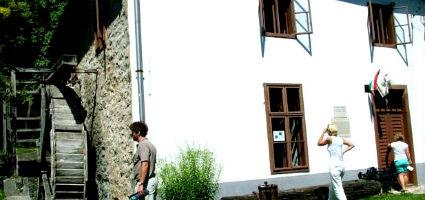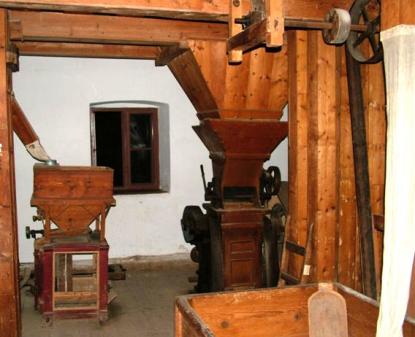2024. April 24. Wednesday
Watermill - Paloznak
 |
Address: 8229, Paloznak Kisfaludy u.16.
Phone number: (87) 446-250
E-mail: csopakph@csopak.hu
Opening hours: 01.05-30.09.: Tue-Sun 16-19
|
The Molnár Kálmán type of watermill was rebuilt in 1910. According to the Balaton researcher Dr. Zákonyi Ferenc, technically it is like the work of the plan cutters of the Bakony in the 19th century.

The half-automatic mills worked like that: Crop was first cleaned on the attic. Then, it was poured into a double gullet. It was useful, since when in one of the gullets the crop was gone and someone went to fetch some more, the other gullet could work. While it worked, the other so-called 'Fahn' was filled up. The flour finally was poured into a sieve where the remaining bran was removed. Then, as the last station of the process, the clean flour was poured into sacks downstairs.
The local history collection shows several tools and equipment used by the peasantry. We also show pots, Roman bricks and bricks from the 19th century, badges, magazines in mills, a title deed and a portrait of Hankóczy Jenő.
The artistic wood engravings by Nagy Lajos are shown in a separate showcase.

The half-automatic mills worked like that: Crop was first cleaned on the attic. Then, it was poured into a double gullet. It was useful, since when in one of the gullets the crop was gone and someone went to fetch some more, the other gullet could work. While it worked, the other so-called 'Fahn' was filled up. The flour finally was poured into a sieve where the remaining bran was removed. Then, as the last station of the process, the clean flour was poured into sacks downstairs.
The local history collection shows several tools and equipment used by the peasantry. We also show pots, Roman bricks and bricks from the 19th century, badges, magazines in mills, a title deed and a portrait of Hankóczy Jenő.
The artistic wood engravings by Nagy Lajos are shown in a separate showcase.
